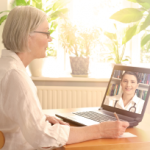
Image Credit: Sergey Nivens/shutterstock.com
“Telemedicine covers a variety of services, but it basically is defined as providing patient services using telecommunications,” says Jonathan Linkous, chief executive officer of the American Telemedicine Association. “With time, the cost of both the technology and the communication services went way down, and we are just beginning to see the use of digital phones, computers and tablets in this area.”
Remote Specialty Care Growing
Perhaps the largest area of growth will be providing specialty care remotely. New technologies allow the use of some basic instruments, such as a stethoscope, otoscope and dermascope, to provide patient care over distances. The adoption of electronic health records allowing physicians access from their offices has made imaging and laboratory values available over the Internet or phone lines.
However, integrating these technologies into rheumatology presents some concerns to physicians in the specialty—not the least of which is the importance of touch in the diagnosis and treatment of patients.
Integration into Touch-Intensive Specialty
“How to integrate telemedicine into a specialty largely dependent on touch is the central question,” says Daniel A. Albert, MD, professor of medicine and pediatrics in Rheumatology at Dartmouth College Geisel School of Medicine in Hanover, N.H. “Figuring out how such a patient examination-specific discipline can cope with the inability to touch the patient is one of the first things to be overcome.”
Most telemedicine projects work around this concern by having a “presenter” with the patient. Usually a specially trained RN, LPN or medical assistant, the presenter gets the person checked in, obtains vital signs and asks about any concerns or complaints. They also help with assessing such things as range of motion, tenderness or warmth of joints, locating rashes, evaluating muscle strength, etc. Presenters can also work the technologies that relay the results of using the stethoscope, zoom the cameras if closer looks are needed or use a handheld camera for more difficult to reach areas.
Addressing Access Issues
In many ways, telemedicine addresses access issues. When deciding if practicing remotely is a viable alternative, both the practice and participating physicians should look at their geographical area to find underserved areas. One of the best uses for telemedicine can be opening up opportunities for specialist treatment to patients that have not had them before. Telemedicine helps reduce, and to some extent eliminate, the number of patients who are lost to follow-up.
“In our area of New Hampshire, we have patients who are very distant in time,” says Dr. Albert. “I see patients who travel six hours or more round trip and have trouble maintaining an ongoing relationship if we don’t have a telemedicine site nearby. I recently saw one person who hasn’t been seen since 2012.”
As older physicians retire in higher numbers, remote practice may be one way to address physician shortage concerns in rheumatology. Because of this, suburban and even smaller urban areas may become viable markets for rheumatologists to practice telemedicine.
Best Telemedicine Patient Controversial
The best patient for telemedicine is one of some controversy. Some suggest in-person appointments for at least the initial assessment.
“What works best for me is to have the first visit face to face,” says Rohit Aggarwal, MD, assistant professor in the Division of Rheumatology at the University of Pittsburgh (Pa.) Medical Center. “After you have decided on a treatment regimen, then you can see them remotely for follow-ups.” However, that is more applicable to more severe or multisystem diseases, such as systemic sclerosis and polymyositis, in which there might be significant importance for touch by an experienced rheumatologist to make the correct diagnosis.
The other model is to see the patient remotely from the first encounter. This has some limitations and can make the differential diagnosis harder. However, with the help of good imaging and a competent presenter, even these patients can be appropriately served.
“You have to base these decisions on the population you are serving and the areas you are trying to help,” says Huzaefah Syed, MD, assistant professor at the Virginia Commonwealth University (VCU) School of Medicine in Richmond. “If you have a lot of stable patients and you don’t need to see them as much as talk to them, then telemedicine is worth doing. We still can learn a lot from watching them move around, or what the patient tells us.”
Setting Up the Host
Once the decision to look into telemedicine has been made, the next thing on the checklist is to make arrangements with a local hospital or physician. Someone will need to host the local telemedicine presence. In most instances, it’s probably easier to work with someone in the community than try to do it on your own.
“There is always an agreement between facilities when you do telemedicine,” says Tamara Broadnax, MS, RN, director of telemedicine at VCU. “The contracts need to clearly define who will be seeing the patients, the doctor’s availabilities, what needs to be done to license, credential and privilege your physician at that facility, who employs the remote staff and other concerns, such as payments.”
There are many ways that these issues can be worked out, and most contracts will reflect the needs of the two parties. Some hosting hospitals may want to pay for services on a per-patient or hourly basis and recover a fixed telemedicine facility fee. Others may want to rent the space and let the physician bill the patient directly. Of course, the practice also has to decide what works best for its needs.
“The situation is individualized according to the needs of the doctors, host and especially the patients,” says Dr. Albert. “Anything goes in the way of structure, [because] it is driven more by demand and other commitments.”
For the most part, telemedicine will not require much additional staff. Current administrative employees should be able to handle the extra work.
The major concern will be in finding the presenter to act as liaison between the doctor and the patient. The person can be an RN, LPN or MA, although those interviewed say a nurse was preferable. If someone is available with a background in rheumatology, so much the better, but training is also important.
Success Depends on the Presenter
“In many ways, the success of the remote location depends on the person at the other end,” says Dr. Aggarwal. “Did they learn what you taught them? Do they understand the medical terminology and what the physician wants them to do? What you don’t want during a telemedicine visit is a communications problem between the doctor and the presenter.”
The relationship with the presenter is another aspect that can change based on the needs of the involved parties. If a practice has a telemedicine presence in a number of places, a person employed by doctors may travel. Other times, it may be a person employed by the local host who works with patients once a week or month, when the rheumatology clinic is held.
Equipment
The actual teleconferencing equipment is another area in which there can be a variety of options available. At the patient’s end is a telemedicine clinical cart, available for around $30,000. It includes the necessary software, camera and assessment equipment. At the provider’s is a desktop unit, which can be purchased for around $3,000. A computer with appropriate Web-enabled telepresence software and a Web camera can be purchased for less than $100. Skype, FaceTime and other commercial packages cannot be used because they are not secure and HIPAA compliant.
“At our center, about 40% of patients at remote sites with no specialists available would forego treatment if they [had to travel] more than two hours,” says Dr. Aggarwal. “Patients are not getting top-quality care. We can expand the reach of the rheumatologist using telemedicine.” the rheumatologist
Kurt Ullman is a freelance writer based in Indiana.



